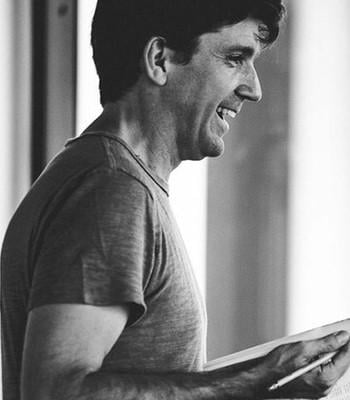
It’s not easy gaining a foothold — no pun intended — in the Los Angeles ballet scene. But Lincoln Jones, who co-founded American Contemporary Ballet (ACB) with Theresa Farrell in 2011 in the City of Angels, continues to buck the odds. Currently the sole artistic director and choreographer of the troupe (Farrell left in 2020), Jones is expanding a repertory that includes works by New York City Ballet co-founder/choreographer George Balanchine and tapper Fred Astaire, as well as reconstructions of important historical ballets and many dozens of his own works, such as The Rite of Spring, and the holiday perennial, The Nutcracker Suite.
ACB is also the only ballet troupe in L.A. to perform exclusively to live music, played by some of the city’s finest classical and jazz musicians. Indeed, March 1 through March 22, ACB will present 10 performances at their “performance venue” (more below), under the title “ACB Jazz.” Showcasing two premieres, a number dubbed “The Charlestons,” and two comedians, the program features music performed by Morgan “Daddy Butterbeans” Jones and his Hot Nine, playing tunes by Louis Armstrong, Duke Ellington, and Jelly Roll Morton, and others.

Lincoln Jones, who was born in Fullerton, CA and began dancing at age 19, explained that the upcoming program incorporates music of the late 1920s to early 1930s. “Morgan Jones — we’re not related — is our music director, and he plays piano and celesta. There’s also trumpet, trombone, two saxes, drums, standup bass, tuba, and a singer, Anastasia Malliaras. ‘The Charlestons’ we did last year. That was the first work in a larger program of the same musical aesthetic, [also called] ‘ACB Jazz.’”
And while it’s a luxury for small ballet companies — or dance troupes in general — to have live music, this has always been a must for Jones, 48, and ACB. “It seems so obvious,” he noted. “We wouldn’t have a live band and recorded dance! That’s essentially the same thing. And live music also sounds totally different. If it’s not live, there is no interacting, [so] for all the reasons you go to see a live performance, it also makes a huge difference to the dancers.”
The company, which Jones says has an annual budget of more than $1 million, currently has 14 dancers, ages 19-30, but is down from 21 since the pandemic. The director, who recently returned from New York where he was auditioning dancers, said that he looks for “tall dancers. For my choreography, they work very well. Once the company is larger, I can see bringing in a broader range [of dancers]. But the smaller the company is, the tighter aesthetically it has to be in different groupings. I also look for dancers that really want to do the kind of work we’re doing. It’s important that they’re being fulfilled.”
Jones also looks for musicality in a dancer. “You can do ballet without dancing. By that I mean you can go through the poses and do them roughly in time, but getting hit with the music [should be] your primary impetus. A lot of times I see dancers who do things technically well – they have beautiful lines - but rhythm isn’t driving them as much as I would like.”
And about those comedians? On the troupe’s website, the program is advises its audience to “speak easy. Dance hard. When you’re tired of the sameness and tameness, this is the place.” It also warns that the “show may contain language that may or may not be objectionable to minors …”
Jones laughed and noted that, “comic Brian Kiley was Conan O’Brien’s main joke writer for years. He may be the best joke writer in L.A., but he [works] clean. The program opens with Kiley and then there’s “The Charlestons.” After that, we serve whisky sours while the band plays. A suite of four dances is next, [with music] by Ellington. Then there’s comedian Matt Donaher.”

If the evening sounds a bit like a Vegas lounge act — with gals on pointe instead of showgirls — that’s part of the fun. And so is ACB’s latest performance venue. The troupe, decidedly not a site-specific one, has nevertheless performed in trendy locations around the city since its founding. In its first years, ACB was on Wilshire Boulevard across from the Los Angeles County Museum of Art, before moving to the 32nd floor of a downtown skyscraper.
“From there,” recalled Jones, “we did sky hopping, and went to 1 California Plaza. Then we went to the garment district. The Fashion Theater was a great space and used for runway shows before they tore it down.”
Jones explained that ACB is able to traverse the city because it has fostered relationships with developers. “They like having us in their spaces. It helps activate them, until, eventually, our space gets leased.”
ACB’s latest location is underground at the Bank of America Plaza on 333 Hope Street, and seats about 100. “It’s perfect for jazz,” exclaims Jones, “but is very hard to describe. There’s a big circle on the upper level. It’s a rotunda and there’s a waterfall pouring in it from three sides. There are high ceilings and [there’s] a ton of room. This is our first show in the space, and it’s one of our best.”
With ACB adding to the cultural landscape of Los Angeles, it’s natural that Jones should have thoughts on the state of contemporary ballet today. “I have a different view than most. It goes back to my answer about musicality. For me, ballet is the best it can be when it’s based on dancing and the dance impetus.
“A lot of what I see,” he added, “tends to be either conceptual or athletic, which is not to say that it’s not impressively athletic. It is. But it doesn’t have that thing I love, which is what Balanchine was so good at: Taking the idea of dancing and putting it into a complex compositional form, so that it’s satisfying on so many levels.”

